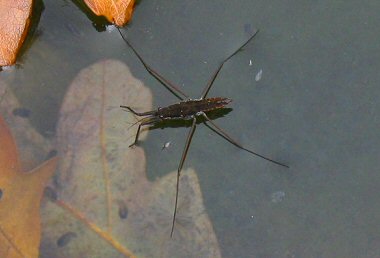The water strider lives on ponds and
small streams, and can walk across the surface of the water. Like all
insects, it has a three-part body (head, thorax and abdomen), six legs,
and two antennae. The water strider's long middle legs move it across
the surface of the water like paddles. The hind legs are used to steer,
and also act as brakes. The short front legs are used to catch prey.
Water striders eat small insects that fall on the water's surface, or
larvae that live just below the surface. Water striders are very
sensitive to motion and vibrations, and use these to find prey. Water striders do not bite people, and because they cannot detect motion above
or below the water's surface, are easy prey themselves for frogs, fish,
and birds.
striders do not bite people, and because they cannot detect motion above
or below the water's surface, are easy prey themselves for frogs, fish,
and birds.
|
The Water Strider propels itself
by pushing backward against the small dimples in the water created
by its legs. |
How is it that water striders can walk on water
without ever falling in or getting wet? The answer has to do with
surface tension. This force between the molecules of the surface acts
like a 'skin', and tends to repel solids. Very light objects are
supported by this force, and the water strider has a very small mass.
The water strider also has feet coated with a surface that repels water,
much like waxed paper. The result is that the tiny insect barely makes
contact with the surface of the water with the tips of its feet, and
where it does make contact, it doesn't break through the surface. |

